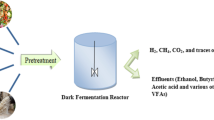Abstract
The syntrophically glycolate-fermenting bacterium in the methanogenic binary coculture FlGlyM was isolated in pure culture (strain FlGlyR) with glyoxylate as sole substrate. This strain disproportionated 12 glyoxylate to 7 glycolate, 10 CO2, and 3 hydrogen. Glyoxylate was oxidized via the malyl-CoA pathway. All enzymes of this pathway, i.e. malyl-CoA lyase/malate: CoA ligase, malic enzyme, and pyruvate synthase, were demonstrated in cell-free extracts. Glycolate dehydrogenase, hydrogenase, and ATPase, as well as menaquinones as potential electron carriers, were present in the membranes. Everted membrane vesicles catalyzed hydrogen-dependent glyoxylate reduction to glycolate [86–207 nmol min-1 (mg protein)-1] coupled to ATP synthesis from ADP and Pi [38–82 nmol min-1 (mg protein)-1]. ATP synthesis was abolished entirely by protonophores or ATPase inhibitors (up to 98 and 94% inhibition, respectively) indicating the involvement of proton-motive force in an electron transport phosphorylation driven by a new glyoxylate respiration with hydrogen as electron donor. Measured reaction rates in vesicle preparations revealed a stoichiometry of ATP formation of 0.2–0.5 ATP per glyoxylate reduced.
Similar content being viewed by others
Abbreviations
- BES :
-
2-Bromoethanesulfonate
- CCCP :
-
Carbonylcyanide m-chlorophenylhydrazone
- DCCD :
-
N,N′-Dicyclohexylcarbodiimide
- DCPIP :
-
2,6-Dichlorophenolindophenol
- DTE :
-
Dithioerythritol
- TCS :
-
3,5,4′,5′-Tetrachlorosalicylanilide
- SF 6847 :
-
3,5-Di-tert-butyl-4-hydroxybenzylidenemalonitrile
References
Beaty PS, McInerney MJ (1987) Growth of Syntrophomonas wolfei in pure cultures on crotonate. Arch Microbiol 147:389–393
Bradford MM (1976) A rapid and sensitive method for the determination of microgram quantities of protein utilizing the principle of protein-dye binding. Anal Biochem 72:248–254
Diekert GB, Thauer NK (1978) Carbon monoxide oxidation by Clostridium thermoaceticum and Clostridium formicoaceticum. J Bacteriol 136:597–606
Dörner C (1992) Biochemie und Energetik der Wasserstoff-Freisetzung in der syntrophen Vergärung von Fettsäuren und Benzoat. Ph.D. thesis, Universität Tübingen, Germany
Friedrich M, Schink B (1991) Fermentative degradation of glyoxylate via malyl-CoA by a new strictly anaerobic bacterium. Arch Microbiol 156:392–397
Friedrich M, Schink B (1993) Hydrogen formation from glycolate driven by reversed electron transport in membrane vesicles of a syntrophic glycolate-oxidizing bacterium. Eur J Biochem 217:233–240
Friedrich M, Laderer U, Schink B (1991) Fermentative degradation of glycolic acid by defined syntrophic cocultures. Arch Microbiol 156:398–404
Hassinen IE, Vuokila PT (1993) Reaction of dicyclohexylcarbodiimide with mitochondrial proteins. Biochim Biophys Acta 1144:107–124
Kröger A, Winkler E (1981) Phosphorylative fumarate reduction in Vibrio succinogenes: stoichiometry of ATP synthesis. Arch Microbiol 129:100–104
Linnett PE, Beechey RB (1979) Inhibitors of the ATP synthase system. Methods Enzymol 55:472–518
Litters N, Schmelzeisen-Redeker G (1989) Experience with fast HPLC in the routine analytical laboratory. GIT Fachz Lab 33:81–83
Mesbah M, Premachandran U, Whitman WB (1989) Precise measurement of the G+C content of deoxyribonucleic acid by high-performance liquid chromatography. Int J Syst Bacteriol 39:159–167
Odom JM, Peck HD (1981) Localization of dehydrogenases, reductases and electron transfer components in the sulfate-reducting bacterium Desulfovibrio gigas. J Bacteriol 147:161–169
Peinemann S, Blaut M, Gottschalk G (1989) ATP synthesis coupled to methane formation from methyl-CoM and H2 catalyzed by vesicles of the methanogenic bacterial strain Göl. Eur J Biochem 186:175–180
Platen H, Schink B (1987) Methanogenic degradation of acetone by an enrichment culture. Arch Microbiol 149:136–141
Schink B (1991) Syntrophism among prokaryotes. In: Balows A, Trüper HG, Dworkin M, Harder W, Schleifer KH (eds) The prokaryotes, 2nd edn. Springer, Berlin Heidelberg New York, pp 276–299
Stams AJM, Kremer DR, Nicolay K, Weenk GH, Hansen TA (1984) Pathway of propionate formation in Desulfobulbus propionicus. Arch Microbiol 139:167–173
Stouthamer AH (1979) The search for correlation between theoretical and experimental growth yields. Int Rev Biochem 21:1–47
Thauer RK, Jungermann K, Decker K (1977) Energy conservation of chemotrophic anaerobic bacteria. Bacteriol Rev 41:100–180
Vogel G, Steinhart R (1976) ATPase of E. coli: purification, dissociation and reconstitution of the active complex from the isolated subunits. Biochemistry 15:208–216
Wallrabenstein C, Schink B (1994) Evidence of reversed electron transport in syntrophic butyrate or benzoate oxidation by Syntrophomonas wolfei and Syntrophus buswellii. Arch Microbiol 162:136–142
Wallrabenstein C, Hauschild E, Schink B (1994) Pure culture and cytological properties of “Syntrophobacter wolinii”. FEMS Microbiol Lett 123:249–254
Widdel F, Pfennig N (1984) Dissimilatory sulfate- or sulfur-reducing bacteria. In: Krieg NR, Holt JG (eds) Bergey's manual of systematic bacteriology, 9th edn, vol 1. Williams & Wilkins, Baltimore, pp 663–679
Zhao H, Yang D, Woese CR, Bryant MP (1990) Assignment of Clostridium bryantii to Syntrophospora bryantii gen. nov., comb. nov., on the basis of a 16S rRNA sequence analysis of its crotonate grown pure culture. Int J Syst Bacteriol 40:40–44
Author information
Authors and Affiliations
Corresponding author
Rights and permissions
About this article
Cite this article
Friedrich, M., Schink, B. Electron transport phosphorylation driven by glyoxylate respiration with hydrogen as electron donor in membrane vesicles of a glyoxylate-fermenting bacterium. Arch. Microbiol. 163, 268–275 (1995). https://doi.org/10.1007/BF00393379
Received:
Accepted:
Issue Date:
DOI: https://doi.org/10.1007/BF00393379




